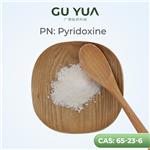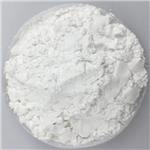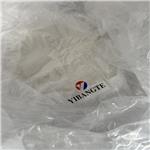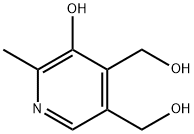- Pyridoxine
-

- $10.00 / 1kg
-
2024-03-08
- CAS:65-23-6
- Min. Order: 1kg
- Purity: 99%
- Supply Ability: 1000kg
- Pyridoxine
-

- $0.00 / 25KG
-
2023-08-30
- CAS:65-23-6
- Min. Order: 1KG
- Purity: 99%
- Supply Ability: 50000KG/month
- Pyridoxine
-

- $0.00 / 1kg
-
2023-05-30
- CAS:65-23-6
- Min. Order: 1kg
- Purity: 99%
- Supply Ability: 500000kg
|
| Product Name: | Pyridoxine | | Synonyms: | 2-Methyl-3-hydroxy-4,5-bis(hydroxymethyl)pyridine;2-Methyl-3-hydroxy-4,5-dihydroxymethyl-pyridin;2-Methyl-4,5-bis(hydroxymethyl)-3-hydroxypyridine;2-Picoline-4,5-dimethanol, 3-hydroxy-;3,4-Pyridinedimethanol, 5-hydroxy-6-methyl-;3-hydroxy-2-picoline-5-dimethanol;3-hydroxy-4,5-bis(hydroxymethyl)-2-methylpyridine;3-Hydroxy-4,5-dimethylol-alpha-picoline | | CAS: | 65-23-6 | | MF: | C8H11NO3 | | MW: | 169.18 | | EINECS: | 200-603-0 | | Product Categories: | Heterocycle-Pyridine series;GANTRISIN;vitamin series;Inhibitors;65-23-6 | | Mol File: | 65-23-6.mol |  |
| | Pyridoxine Chemical Properties |
| Hazard Codes | Xi | | Risk Statements | 36/37/38 | | Safety Statements | 26-36 | | WGK Germany | 3 | | RTECS | UV1350000 | | F | 8-10 | | HS Code | 29362500 |
| | Pyridoxine Usage And Synthesis |
| Description | Pyridoxine hydrochloride provides pyridoxine, which is also known as vitamin B6. Vitamin B6 is naturally found in foods such as cereals, beans, vegetables, liver, meat, and eggs. Vitamin B6 functionalizes as a coenzyme in the metabolism of protein, carbohydrate, and fat. Vitamin 6 is needed to maintain the health of nerves, skin, and red blood cells.
Pyridoxine is used to prevent or treat vitamin B6 deficiency caused by inadequate dietary intake. It is also used to treat drug induced deficiency in patients taking isoniazid or oral contraceptives.
| | Pharmacodynamics | Vitamin B6 (pyridoxine) is a water-soluble vitamin used in the prophylaxis and treatment of vitamin B6 deficiency and peripheral neuropathy in those receiving isoniazid (isonicotinic acid hydrazide, INH). Vitamin B6 has been found to lower systolic and diastolic blood pressure in a small group of subjects with essential hypertension. Hypertension is another risk factor for atherosclerosis and coronary heart disease. Another study showed pyridoxine hydrochloride to inhibit ADP- or epinephrine-induced platelet aggregation and to lower total cholesterol levels and increase HDL-cholesterol levels, again in a small group of subjects. Vitamin B6, in the form of pyridoxal 5'-phosphate, was found to protect vascular endothelial cells in culture from injury by activated platelets. Endothelial injury and dysfunction are critical initiating events in the pathogenesis of atherosclerosis. | | Toxicity | Oral Rat LD50 = 4 gm/kg. Toxic effects include convulsions, dyspnea, hypermotility, diarrhea, ataxia and muscle weakness. | | References | [1] http://www.webmd.com
[2] https://dailymed.nlm.nih.gov
| | Chemical Properties | crystalline solid | | Physical properties | It is one kind of B vitamins, containing pyridoxine or pyridoxal or pyridoxamine.
Appearance: colorless crystals at room temperature. Solubility: soluble in water and
ethanol. Stability: stable in acid liquor but easily destroyed in alkali liquor. Pyridoxol
is resistant to high temperature, but pyridoxal and pyridoxamine are not. | | History | The discovery of vitamin was tortuous and legendary. After fat-soluble A and water soluble B were discovered by the year of 1915, the discovery of vitamins entered
into a rapid developed period. In separation process of riboflavin by Kuhn and his
colleagues, they noticed the unusual relationship between growth-promoting activ ity and fluorescence of extracts. Then they supposed that the existence of no fluorescent substances were very necessary for growth-promoting activity of
riboflavin. And they considered this phenomenon as the evidence of a second chem ical existence in the thermostable complex. At last, they named this substance as
vitamin B6 .
Vitamin B6 is widely distributed in foods, including meats, whole-grain products
(especially wheat), vegetables, and nuts. In the cereal grains, vitamin B6 is concen trated primarily in the germ and aleuronic layer. Thus, the refining of grains in the
production of flours, which removes much of these fractions, results in substantial
reductions of vitamin B6 content. The chemical forms of vitamin B6 tend to vary
among foods between plant and animal origin: plant tissues contain most pyridox ine (the free alcohol form, pyridoxol), whereas animal tissues contain most pyri doxal and pyridoxamine. | | Uses | Vitamin B6, a water-soluble vitamin with a solubility of 1 g in 5 ml of water. It functions in the utilization of protein and is an essential nutrient in enzyme reactions. It is necessary for proper growth. During processing, there is a loss due to leaching of the vitamin in water. It is destroyed by high temperatures, high irradiation, and exposure to light. During storage, loss increases with temperature and storage time. It is found in liver, eggs, and meats. | | Uses | antibacterial | | Uses | pyridoxine HCL is a skin-conditioning agent that is also widely used in hair products. | | Indications | Vitamin B6 deficiency | | Definition | ChEBI: A hydroxymethylpyridine with hydroxymethyl groups at positions 4 and 5, a hydroxy group at position 3 and a methyl group at position 2. The 4-methanol form of vitamin B6, it is converted intoto pyridoxal phosphate which is a coenzyme f
r synthesis of amino acids, neurotransmitters, sphingolipids and aminolevulinic acid. | | Brand name | Hexa-Betalin (Lilly). | | World Health Organization (WHO) | Pyridoxine (vitamin B6) is listed in theWHO Model List of
Essential Drugs. | | General Description | The discovery of vitamin B6 is generally ascribed to Paul Gy?rgy who first realized there was a vitamin that was distinctly different from vitamin B2 in 1934. Pyridoxine (PN) is the C4 hydroxymethyl derivative, pyridoxal (PL) is the C4 formyl derivative and pyridoxamine (PM) is the C4 aminomethyl derivative of 5-(hydroxymethyl)- 2-methylpyridin-3-ol). Each of these are also converted to their corresponding 5'-phosphate derivatives referred to as pyridoxine 5'-phosphate (PNP), pyridoxal 5'-phosphate (PLP), and pyridoxamine 5'-phosphate (PMP), respectively . Because of their ability to interconvert, all are considered active forms of vitamin B6 in vivo. Although PLP is the major coenzyme form, PMP can also function as a coenzyme primarily in aminotransferases. The major metabolite is 4-pyridoxic acid, which is excreted in the urine. | | Biological Activity | pyridoxine (pyridoxol, vitamin b6, gravidox), also known as vitamin b6, is a form of vitamin b6 found commonly in food and used as dietary supplement. pyridoxine exerts antioxidant effects in cell model of alzheimer's disease via the nrf-2/ho-1 pathway. | | Biochem/physiol Actions | Pyridoxine plays a key role in cell maintenance and amino acid metabolism. Deficiency of vitamin B6 leads to anemia especially in pregnant women and seizures in newborns. It serves as cofactor for heme biosynthesis during δ-amino levulinic acid formation, γ-aminobutyric acid (GABA) transaminase and glutamic acid decarboxylase. Vitamin B6 also helps in reactive oxygen species (ROS) scavenging and helps plants in overcoming the abiotic and biotic stress. | | Pharmacology | The metabolically active form of vitamin B6 is pyridoxal phosphate, which serves as
a coenzyme of numerous enzymes, most of which are involved in the metabolism of
amino acids. Vitamin B6 functions through the following general mechanisms:
decarboxylation, transamination, racemization, elimination, replacement reactions,
and β-group interconversions.
Pyridoxal phosphate is practically involved in all amino acid metabolism reac tions, such as transaminations, transsulfuration, and selenoamino acid metabolism,
in both their biosynthesis and their catabolism. Vitamin B6 also plays an important
role in the tryptophan–niacin conversion, histamine synthesis, neurotransmitter syn thesis, and hemoglobin synthesis.
Vitamin B6 has two roles in gluconeogenesis, transaminations and glycogen uti lization. It is required for the utilization of glycogen to release glucose by serving as
a coenzyme of glycogen phosphorylase. | | Clinical Use | Pyridoxine is indicated in the treatment and prevention of known or suspected vitamin B6 deficiency, which is most likely to occur in the setting of alcoholism in developed countries. At least seven genetic disorders that result in a vitamin B6 deficiency syndrome in the presence of an adequate dietary intake have been identified. These result from defects in enzymes that are responsible for the bioactivation or utilization of vitamin B6. | | Safety Profile | Moderately toxic by ingestion, subcutaneous, intravenous, and intraperitoneal routes. Human systemic
effects: ataxia, local anesthetic, paresthesia. When heated to decomposition it emits toxic fumes of Nox | | Veterinary Drugs and Treatments | Pyridoxine use in veterinary medicine is relatively infrequent. It
may be of benefit in the treatment of isoniazid (INH) or crimidine
(an older rodenticide) toxicity. Pyridoxine deficiency is apparently
extremely rare in dogs or cats able to ingest food. Cats with severe
intestinal disease may have a greater requirement for pyridoxine in
their diet. Experimentally, pyridoxine has been successfully used
in dogs to reduce the cutaneous toxicity associated with doxorubicin
containing pegylated liposomes (Doxil?). Pyridoxine has been
demonstrated to suppress the growth of feline mammary tumors
(cell line FRM) in vitro.
In humans, labeled uses for pyridoxine include pyridoxine deficiency
and intractable neonatal seizures secondary to pyridoxine
dependency syndrome. Unlabeled uses include premenstrual syndrome
(PMS), carpal tunnel syndrome, tardive dyskinesia secondary
to antipsychotic drugs, nausea and vomiting in pregnancy, hyperoxaluria
type 1 and oxalate kidney stones, and for the treatment
of isoniazid (INH), cycloserine, hydrazine or Gyometra mushroom
poisonings. |
| | Pyridoxine Preparation Products And Raw materials |
| Raw materials | Sucrose-->3-amino-4,5-bis(aminomethyl)2-methylpyridine trihydrochloride-->1,5-dihydro-3-isopropyl-8-methyl-[1,3]dioxepino[5,6-c]pyridin-9-ol-->1,5-dihydro-3-isopropyl-8-methyl-[1,3]dioxepino[5,6-c]pyridin-9-yl acetate-->dimethyl 5-hydroxy-6-methylpyridine-3,4-dicarboxylate-->diethyl 5-hydroxy-6-methylpyridine-3,4-dicarboxylate-->3,4-Pyridinedicarboxylic acid, 5-hydroxy-6-methyl--->Glycine, N-[[3-hydroxy-5-(hydroxymethyl)-2-methyl-4-pyridinyl]methyl]--->4-Pyridoxic acid-->D-ALTROSE-->pyridoxal-->D-(+)-ALLOSE-->pyridoxamine | | Preparation Products | Pyridoxal phosphate-->5-CHLOROMETHYL-3-HYDROXY-4-HYDROXYMETHYL-2-METHYLPYRIDINE-->1,3-dihydro-6-methylfuro[3,4-c]pyridin-7-ol |
|